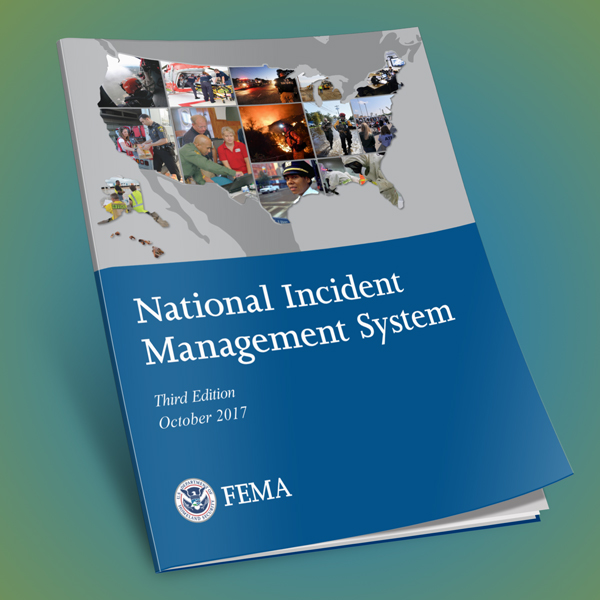Share Your Feedback
The REMS TA Center seeks your feedback to ensure that the Website is continually enhanced to meet your needs.

Access resources on NIMS:
Fact Sheet Tool Box Enhancing School and Higher Ed Safety Leadership CapabilitiesNATIONAL INCIDENT MANAGEMENT SYSTEM
The National Incident Management System (NIMS) is the United States’ single, comprehensive system for managing domestic incidents and is suitable for all schools, institutions of higher education, and education agencies at the local, state, and regional levels. It is a part of the National Preparedness System, reinforces the National Response Framework, and provides a flexible approach for collaborating across disciplines and all levels of government. By adopting NIMS and integrating it into their emergency operations plans, education agencies can
- Ensure that planning teams, response teams, and the entire community are utilizing the same terminology;
- Seamlessly integrate facilities, equipment, personnel, procedures, and communications operating within a common organizational structure;
- Establish common processes for planning and managing resources;
- Coordinate their emergency management planning efforts with their community partners’ efforts; and
- Continually improve by means of incidents, exercises, and training.
Components of NIMS
NIMS comprises three components: resource management, command and coordination, and communication and information management. Together, they unify the vocabulary, systems, and processes of agencies across communities and the nation. These components are described below.
Resource Management
Personnel, teams, facilities, equipment, and supplies are all resources that can be utilized to address potential hazards and threats. Since one single entity does not own or maintain all resources necessary, it is important to coordinate, collaborate, and systematically leverage and share resources within a jurisdiction. Resource management includes resource management preparedness (e.g., qualifying, certifying, and credentialing personnel), resource management during an incident (e.g., mobilizing, tracking, reimbursing, restocking), and mutual aid (e.g., agreements and compacts).
Command and Coordination
Organizational structures, defined leadership roles, and clear processes are paramount for incident management to be coordinated. These can help an entire jurisdiction and even multiple jurisdictions manage an incident efficiently and effectively. Command and coordination includes, but is not limited to, the Incident Command System and Emergency Operations Centers.
Communications and Information Management
Obtaining accurate, timely, and relevant information is critical to maintaining situational awareness and managing an incident. Decision-makers must also have the means to disseminate information to incident personnel. Communications and information management includes communications management, incident, and communications standards and formats.
Implementation Resources
NIMS
Guidance
U.S. Department of Homeland Security, Federal Emergency Management Agency
U.S. Department of Homeland Security, Federal Emergency Management Agency
Resources
- Implementing the National Incident Management System (NIMS): Practitioner-Oriented Strategies for Education Agencies Fact Sheet
REMS TA Center - National Incident Management System (NIMS) 2017
U.S. Department of Homeland Security, Federal Emergency Management Agency, Emergency Management Institute - National Incident Management System Web Page
U.S. Department of Homeland Security, Federal Emergency Management Agency
Tools
- Tool Box
REMS TA Center
Training
- IS-700.B: An Introduction to the National Incident Management System Online Course
U.S. Department of Homeland Security, Federal Emergency Management Agency, Emergency Management Institute - National Incident Management System Training Program
U.S. Department of Homeland Security, Federal Emergency Management Agency
Incident Command System
Guidance
- National Incident Management System Guidance for Public Information Officers
U.S. Department of Homeland Security, Federal Emergency Management Agency - National Incident Management System Intelligence/Investigations Function Guidance and Field Operations Guide
U.S. Department of Homeland Security
Resources
- ICS Resource Center
U.S. Department of Homeland Security, Federal Emergency Management Agency, Emergency Management Institute
Tools
- Resource Typing Library Tool
U.S. Department of Homeland Security, Federal Emergency Management Agency - Tool Box
REMS TA Center
Training
- IS-100.C: Introduction to the Incident Command System Online Course
U.S. Department of Homeland Security, Federal Emergency Management Agency, Emergency Management Institute - IS-200.C: Basic Incident Command System for Initial Response Online Course
U.S. Department of Homeland Security, Federal Emergency Management Agency, Emergency Management Institute
Emergency Operations Centers
Guidance
- Emergency Operations Center Guidance and Tools Web Page
U.S. Department of Homeland Security, Federal Emergency Management Agency - National Incident Management System Guideline for the National Qualification System
U.S. Department of Homeland Security, Federal Emergency Management Agency
Resources
- National Incident Management System Emergency Operations Center How-To Quick Reference Guide
U.S. Department of Homeland Security, Federal Emergency Management Agency
Tools
- Emergency Operations Center Guidance and Tools Web Page
U.S. Department of Homeland Security, Federal Emergency Management Agency - Tool Box
REMS TA Center
Training
- IS-2200: Basic Emergency Operations Center Functions Online Course
U.S. Department of Homeland Security, Federal Emergency Management Agency, Emergency Management Institute
Resource Management and Mutual Aid
Guidance
- National Incident Management System Guideline for Mutual Aid
U.S. Department of Homeland Security, Federal Emergency Management Agency - National Incident Management System Guideline for Resource Management Preparedness
U.S. Department of Homeland Security, Federal Emergency Management Agency
Resources
- National Intercollegiate Mutual Aid Agreement
International Association of Emergency Managers-USA Universities & Colleges Caucus
Tools
- Resource Typing Library Tool
U.S. Department of Homeland Security, Federal Emergency Management Agency - Tool Box
REMS TA Center
Training
- IS-703.B: National Incident Management System Resource Management Online Course
U.S. Department of Homeland Security, Federal Emergency Management Agency, Emergency Management Institute - IS-706: NIMS Intrastate Mutual Aid — An Introduction Online Course
U.S. Department of Homeland Security, Federal Emergency Management Agency, Emergency Management Institute


